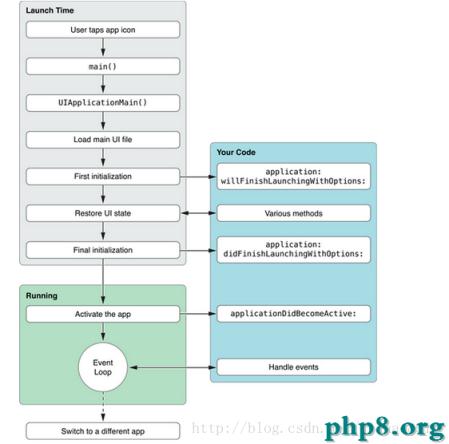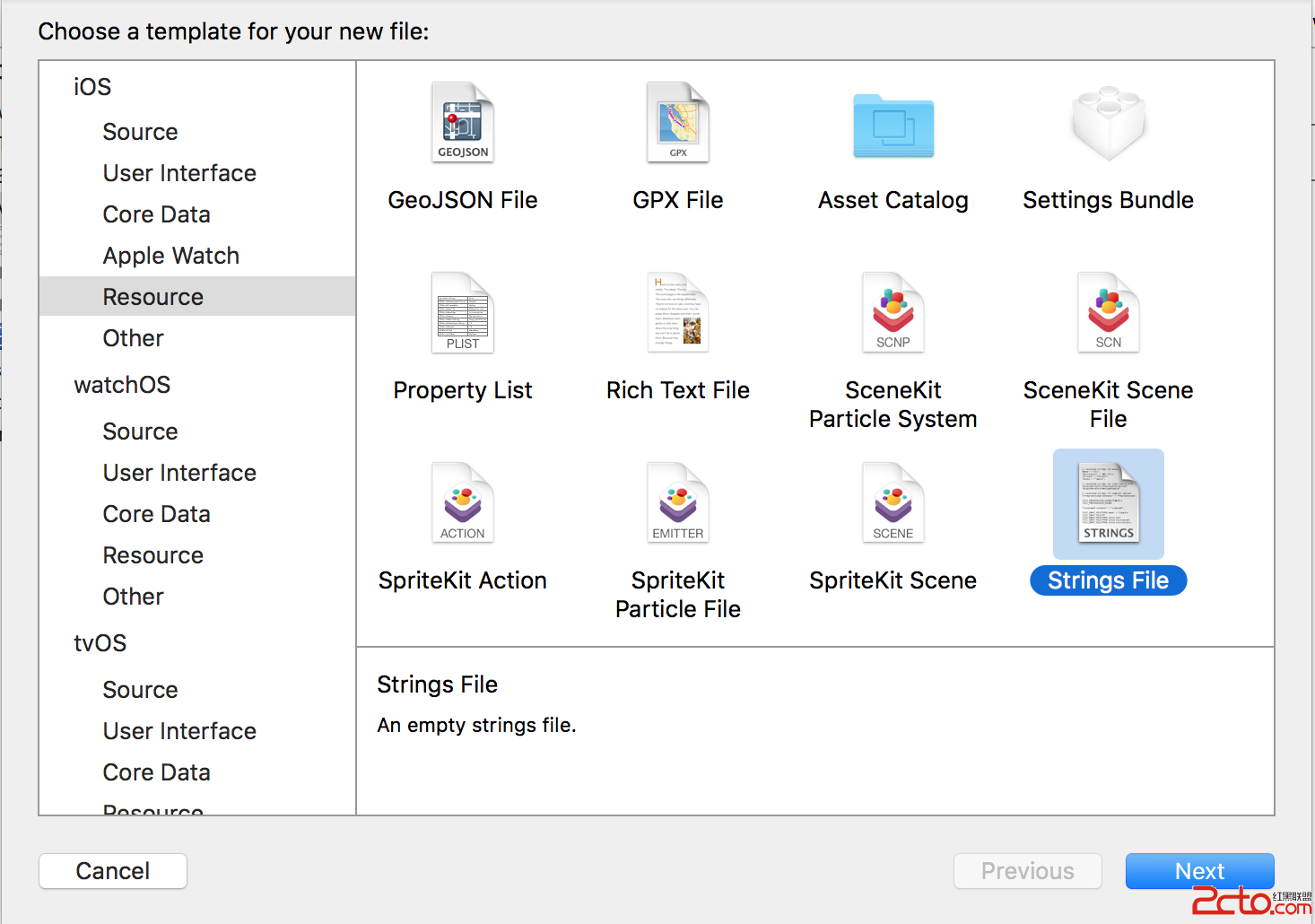iOS開辟中音頻對象類的封裝和音樂播放器的細節掌握
1、掌握器間數據傳遞
兩個掌握器之間數據的傳遞
第一種辦法: self.parentViewController.music=self.music[indexPath.row];不克不及知足
第二種做法:把全部數組傳遞給它
第三種做法:設置一個數據源,設置播放掌握器的數據源是這個掌握器。self.parentViewController.dataSource=self;利益:沒有耦合性,任何完成了協定的可以作為數據源。
第四種做法:把全部項目會應用到的音頻資本交給一個對象類去治理,如許就不消傳遞曩昔了。直接向對象類索要資本便可以。
2、封裝一個音頻對象類
新建一個音頻對象類,用來治理音樂數據(音樂模子)

對象類中的代碼設計以下:
YYMusicTool.h文件
//
// YYMusicTool.h
//
#import <Foundation/Foundation.h>
@class YYMusicModel;
@interface YYMusicTool : NSObject
/**
* 前往一切的歌曲
*/
+ (NSArray *)musics;
/**
* 前往正在播放的歌曲
*/
+ (YYMusicModel *)playingMusic;
+ (void)setPlayingMusic:(YYMusicModel *)playingMusic;
/**
* 下一首歌曲
*/
+ (YYMusicModel *)nextMusic;
/**
* 上一首歌曲
*/
+ (YYMusicModel *)previousMusic;
@end
YYMusicTool.m文件
//
// YYMusicTool.m
//
#import "YYMusicTool.h"
#import "YYMusicModel.h"
#import "MJExtension.h"
@implementation YYMusicTool
static NSArray *_musics;
static YYMusicModel *_playingMusic;
/**
* @return 前往一切的歌曲
*/
+(NSArray *)musics
{
if (_musics==nil) {
_musics=[YYMusicModel objectArrayWithFilename:@"Musics.plist"];
}
return _musics;
}
+(void)setPlayingMusic:(YYMusicModel *)playingMusic
{
/*
*假如沒有傳入須要播放的歌曲,或許是傳入的歌曲名不在音樂庫中,那末就直接前往
假如須要播放的歌曲就是以後正在播放的歌曲,那末直接前往
*/
if (!playingMusic || ![[self musics]containsObject:playingMusic]) return;
if (_playingMusic == playingMusic) return;
_playingMusic=playingMusic;
}
/**
* 前往正在播放的歌曲
*/
+(YYMusicModel *)playingMusic
{
return _playingMusic;
}
/**
* 下一首歌曲
*/
+(YYMusicModel *)nextMusic
{
//設定一個初值
int nextIndex = 0;
if (_playingMusic) {
//獲得以後播放音樂的索引
int playingIndex = [[self musics] indexOfObject:_playingMusic];
//設置下一首音樂的索引
nextIndex = playingIndex+1;
//檢討數組越界,假如下一首音樂是最初一首,那末重置為0
if (nextIndex>=[self musics].count) {
nextIndex=0;
}
}
return [self musics][nextIndex];
}
/**
* 上一首歌曲
*/
+(YYMusicModel *)previousMusic
{
//設定一個初值
int previousIndex = 0;
if (_playingMusic) {
//獲得以後播放音樂的索引
int playingIndex = [[self musics] indexOfObject:_playingMusic];
//設置下一首音樂的索引
previousIndex = playingIndex-1;
//檢討數組越界,假如下一首音樂是最初一首,那末重置為0
if (previousIndex<0) {
previousIndex=[self musics].count-1;
}
}
return [self musics][previousIndex];
}
@end
3、封裝一個音樂播下班具類
該對象類中的代碼設計以下:
YYAudioTool.h文件
//
// YYAudioTool.h
//
#import <Foundation/Foundation.h>
#import <AVFoundation/AVFoundation.h>
@interface YYAudioTool : NSObject
/**
*播放音樂文件
*/
+(BOOL)playMusic:(NSString *)filename;
/**
*暫停播放
*/
+(void)pauseMusic:(NSString *)filename;
/**
*播放音樂文件
*/
+(void)stopMusic:(NSString *)filename;
/**
*播放音效文件
*/
+(void)playSound:(NSString *)filename;
/**
*燒毀音效
*/
+(void)disposeSound:(NSString *)filename;
@end
YYAudioTool.m文件
//
// YYAudioTool.m
//
#import "YYAudioTool.h"
@implementation YYAudioTool
/**
*寄存一切的音樂播放器
*/
static NSMutableDictionary *_musicPlayers;
+(NSMutableDictionary *)musicPlayers
{
if (_musicPlayers==nil) {
_musicPlayers=[NSMutableDictionary dictionary];
}
return _musicPlayers;
}
/**
*寄存一切的音效ID
*/
static NSMutableDictionary *_soundIDs;
+(NSMutableDictionary *)soundIDs
{
if (_soundIDs==nil) {
_soundIDs=[NSMutableDictionary dictionary];
}
return _soundIDs;
}
/**
*播放音樂
*/
+(BOOL)playMusic:(NSString *)filename
{
if (!filename) return NO;//假如沒有傳入文件名,那末直接前往
//1.掏出對應的播放器
AVAudioPlayer *player=[self musicPlayers][filename];
//2.假如播放器沒有創立,那末就停止初始化
if (!player) {
//2.1音頻文件的URL
NSURL *url=[[NSBundle mainBundle]URLForResource:filename withExtension:nil];
if (!url) return NO;//假如url為空,那末直接前往
//2.2創立播放器
player=[[AVAudioPlayer alloc]initWithContentsOfURL:url error:nil];
//2.3緩沖
if (![player prepareToPlay]) return NO;//假如緩沖掉敗,那末就直接前往
//2.4存入字典
[self musicPlayers][filename]=player;
}
//3.播放
if (![player isPlaying]) {
//假如以後沒處於播放狀況,那末就播放
return [player play];
}
return YES;//正在播放,那末就前往YES
}
+(void)pauseMusic:(NSString *)filename
{
if (!filename) return;//假如沒有傳入文件名,那末就直接前往
//1.掏出對應的播放器
AVAudioPlayer *player=[self musicPlayers][filename];
//2.暫停
[player pause];//假如palyer為空,那相當於[nil pause],是以這裡可以不消做處置
}
+(void)stopMusic:(NSString *)filename
{
if (!filename) return;//假如沒有傳入文件名,那末就直接前往
//1.掏出對應的播放器
AVAudioPlayer *player=[self musicPlayers][filename];
//2.停滯
[player stop];
//3.將播放器從字典中移除
[[self musicPlayers] removeObjectForKey:filename];
}
//播放音效
+(void)playSound:(NSString *)filename
{
if (!filename) return;
//1.掏出對應的音效
SystemSoundID soundID=[[self soundIDs][filename] unsignedIntegerValue];
//2.播放音效
//2.1假如音效ID不存在,那末就創立
if (!soundID) {
//音效文件的URL
NSURL *url=[[NSBundle mainBundle]URLForResource:filename withExtension:nil];
if (!url) return;//假如URL不存在,那末就直接前往
OSStatus status = AudIOServicesCreateSystemSoundID((__bridge CFURLRef)(url), &soundID);
NSLog(@"%ld",status);
//存入到字典中
[self soundIDs][filename]=@(soundID);
}
//2.2有音效ID後,播放音效
AudIOServicesPlaySystemSound(soundID);
}
//燒毀音效
+(void)disposeSound:(NSString *)filename
{
//假如傳入的文件名為空,那末就直接前往
if (!filename) return;
//1.掏出對應的音效
SystemSoundID soundID=[[self soundIDs][filename] unsignedIntegerValue];
//2.燒毀
if (soundID) {
AudIOServicesDisposeSystemSoundID(soundID);
//2.1燒毀後,從字典中移除
[[self soundIDs]removeObjectForKey:filename];
}
}
@end
4、在音樂播放掌握器中的代碼處置
YYPlayingViewController.m文件
//
// YYPlayingViewController.m
//
#import "YYPlayingViewController.h"
#import "YYMusicTool.h"
#import "YYMusicModel.h"
#import "YYAudioTool.h"
@interface YYPlayingViewController ()
@property (weak, nonatomic) IBOutlet UIImageView *iconView;
@property (weak, nonatomic) IBOutlet UILabel *songLabel;
@property (weak, nonatomic) IBOutlet UILabel *singerLabel;
@property (weak, nonatomic) IBOutlet UILabel *durationLabel;
@property(nonatomic,strong)YYMusicModel *playingMusic;
- (IBAction)exit;
@end
@implementation YYPlayingViewController
#pragma mark-公共辦法
-(void)show
{
//1.禁用全部app的點擊事宜
UIWindow *Window=[UIApplication sharedApplication].keyWindow;
window.userInteractionEnabled=NO;
//2.添加播放界面
//設置View的年夜小為籠罩全部窗口
self.view.frame=window.bounds;
//設置view顯示
self.view.hidden=NO;
//把View添加到窗口上
[window addSubview:self.view];
//3.檢測能否換了歌曲
if (self.playingMusic!=[YYMusicTool playingMusic]) {
[self RresetPlayingMusic];
}
//4.應用動畫讓View顯示
self.view.y=self.view.height;
[UIView animateWithDuration:0.25 animations:^{
self.view.y=0;
} completion:^(BOOL finished) {
//設置音樂數據
[self starPlayingMusic];
window.userInteractionEnabled=YES;
}];
}
#pragma mark-公有辦法
//重置正在播放的音樂
-(void)RresetPlayingMusic
{
//1.重置界面數據
self.iconView.image=[UIImage imageNamed:@"play_cover_pic_bg"];
self.songLabel.text=nil;
self.singerLabel.text=nil;
//2.停滯播放
[YYAudioTool stopMusic:self.playingMusic.filename];
}
//開端播放音樂數據
-(void)starPlayingMusic
{
//1.設置界面數據
//掏出以後正在播放的音樂
// YYMusicModel *playingMusic=[YYMusicTool playingMusic];
//假如以後播放的音樂就是傳入的音樂,那末就直接前往
if (self.playingMusic==[YYMusicTool playingMusic]) return;
//存取音樂
self.playingMusic=[YYMusicTool playingMusic];
self.iconView.image=[UIImage imageNamed:self.playingMusic.icon];
self.songLabel.text=self.playingMusic.name;
self.singerLabel.text=self.playingMusic.singer;
//2.開端播放
[YYAudioTool playMusic:self.playingMusic.filename];
}
#pragma mark-外部的按鈕監聽辦法
//前往按鈕
- (IBAction)exit {
//1.禁用全部app的點擊事宜
UIWindow *window=[UIApplication sharedApplication].keyWindow;
window.userInteractionEnabled=NO;
//2.動畫隱蔽View
[UIView animateWithDuration:0.25 animations:^{
self.view.y=window.height;
} completion:^(BOOL finished) {
window.userInteractionEnabled=YES;
//設置view隱蔽可以或許節儉一些機能
self.view.hidden=YES;
}];
}
@end
留意:先讓用戶看到界面上的一切器械後,再開端播放歌曲。
提醒:普通的播放器須要做一個重置的操作。
當從一首歌切換到別的一首時,應當先把上一首的信息刪除,是以在show動畫顯示之前,應當檢測能否換了歌曲,假如換了歌曲,則應當做一次重置操作。
完成後果(可以或許順遂的切換和播放歌曲,上面是界面顯示):
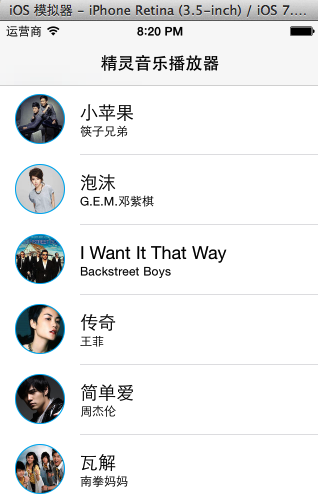
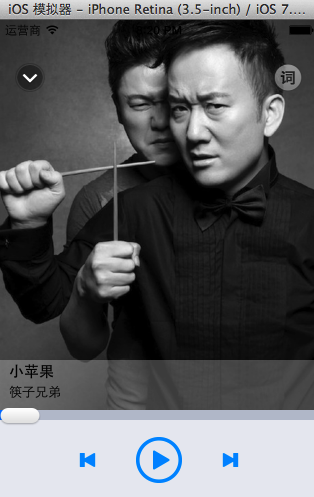
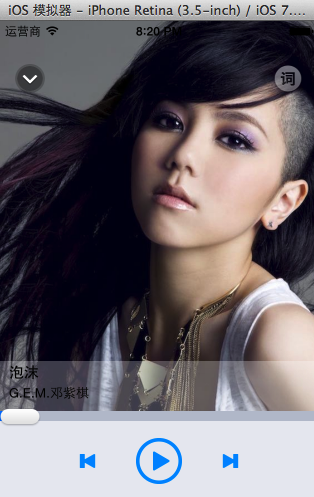
5、彌補代碼
YYMusicsViewController.m文件
//
// YYMusicsViewController.m
//
#import "YYMusicsViewController.h"
#import "YYMusicModel.h"
#import "MJExtension.h"
#import "YYMusicCell.h"
#import "YYPlayingViewController.h"
#import "YYMusicTool.h"
@interface YYMusicsViewController ()
@property(nonatomic,strong)YYPlayingViewController *playingViewController;
@end
@implementation YYMusicsViewController
#pragma mark-懶加載
-(YYPlayingViewController *)playingViewController
{
if (_playingViewController==nil) {
_playingViewController=[[YYPlayingViewController alloc]init];
}
return _playingViewController;
}
- (void)viewDidLoad
{
[super viewDidLoad];
}
#pragma mark - Table view data source
/**
*一共若干組
*/
-(NSInteger)numberOfSectionsInTableView:(UITableView *)tableView
{
return 1;
}
/**
*每組若干行
*/
-(NSInteger)tableView:(UITableView *)tableView numberOfRowsInSection:(NSInteger)section
{
return [YYMusicTool musics].count;
}
/**
*每組每行的cell
*/
-(UITableViewCell *)tableView:(UITableView *)tableView cellForRowAtIndexPath:(NSIndexPath *)indexPath
{
YYMusicCell *cell=[YYMusicCell cellWithtableView:tableView];
cell.music=[YYMusicTool musics][indexPath.row];
return cell;
}
/**
* 設置每一個cell的高度
*/
-(CGFloat)tableView:(UITableView *)tableView heightForRowAtIndexPath:(NSIndexPath *)indexPath
{
return 70;
}
/**
* cell的點擊事宜
*/
-(void)tableView:(UITableView *)tableView didSelectRowAtIndexPath:(NSIndexPath *)indexPath
{
//1.撤消選中被點擊的這行
[tableView deselectRowAtIndexPath:indexPath animated:YES];
//2.設置正在播放的歌曲
[YYMusicTool setPlayingMusic:[YYMusicTool musics][indexPath.row]];
//挪用公共辦法
[self.playingViewController show];
// //履行segue跳轉
// [self performSegueWithIdentifier:@"music2playing" sender:nil];
}
@end
6、一些細節掌握
再來看一個完成的後果:
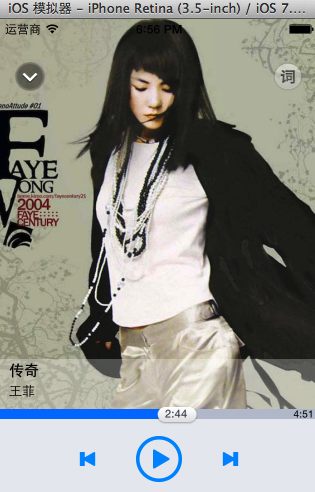
完全的代碼
YYPlayingViewController.m文件
//
// YYPlayingViewController.m
// 20-音頻處置(音樂播放器1)
//
// Created by apple on 14-8-13.
// Copyright (c) 2014年 yangyong. All rights reserved.
//
#import "YYPlayingViewController.h"
#import "YYMusicTool.h"
#import "YYMusicModel.h"
#import "YYAudioTool.h"
@interface YYPlayingViewController ()
//進度條
@property (weak, nonatomic) IBOutlet UIView *progressView;
//滑塊
@property (weak, nonatomic) IBOutlet UIButton *slider;
@property (weak, nonatomic) IBOutlet UIImageView *iconView;
@property (weak, nonatomic) IBOutlet UILabel *songLabel;
@property (weak, nonatomic) IBOutlet UILabel *singerLabel;
//以後播放的音樂的時長
@property (weak, nonatomic) IBOutlet UILabel *durationLabel;
//正在播放的音樂
@property(nonatomic,strong)YYMusicModel *playingMusic;
//音樂播放器對象
@property(nonatomic,strong)AVAudioPlayer *player;
//准時器
@property(nonatomic,strong)NSTimer *CurrentTimeTimer;
- (IBAction)exit;
- (IBAction)tapProgressBg:(UITapGestureRecognizer *)sender;
- (IBAction)panSlider:(UIPanGestureRecognizer *)sender;
@end
@implementation YYPlayingViewController
#pragma mark-公共辦法
-(void)show
{
//1.禁用全部app的點擊事宜
UIWindow *window=[UIApplication sharedApplication].keyWindow;
window.userInteractionEnabled=NO;
//2.添加播放界面
//設置View的年夜小為籠罩全部窗口
self.view.frame=window.bounds;
//設置view顯示
self.view.hidden=NO;
//把View添加到窗口上
[window addSubview:self.view];
//3.檢測能否換了歌曲
if (self.playingMusic!=[YYMusicTool playingMusic]) {
[self RresetPlayingMusic];
}
//4.應用動畫讓View顯示
self.view.y=self.view.height;
[UIView animateWithDuration:0.25 animations:^{
self.view.y=0;
} completion:^(BOOL finished) {
//設置音樂數據
[self starPlayingMusic];
window.userInteractionEnabled=YES;
}];
}
#pragma mark-公有辦法
//重置正在播放的音樂
-(void)RresetPlayingMusic
{
//1.重置界面數據
self.iconView.image=[UIImage imageNamed:@"play_cover_pic_bg"];
self.songLabel.text=nil;
self.singerLabel.text=nil;
//2.停滯播放
[YYAudioTool stopMusic:self.playingMusic.filename];
//把播放器停止清空
self.player=nil;
//3.停滯准時器
[self removeCurrentTime];
}
//開端播放音樂數據
-(void)starPlayingMusic
{
//1.設置界面數據
//假如以後播放的音樂就是傳入的音樂,那末就直接前往
if (self.playingMusic==[YYMusicTool playingMusic])
{
//把准時器加出來
[self addCurrentTimeTimer];
return;
}
//存取音樂
self.playingMusic=[YYMusicTool playingMusic];
self.iconView.image=[UIImage imageNamed:self.playingMusic.icon];
self.songLabel.text=self.playingMusic.name;
self.singerLabel.text=self.playingMusic.singer;
//2.開端播放
self.player = [YYAudioTool playMusic:self.playingMusic.filename];
//3.設置時長
//self.player.duration; 播放器正在播放的音樂文件的時光長度
self.durationLabel.text=[self strWithTime:self.player.duration];
//4.添加准時器
[self addCurrentTimeTimer];
}
/**
*把時光長度-->時光字符串
*/
-(NSString *)strWithTime:(NSTimeInterval)time
{
int minute=time / 60;
int second=(int)time % 60;
return [NSString stringWithFormat:@"%d:%d",minute,second];
}
#pragma mark-准時器掌握
/**
* 添加一個准時器
*/
-(void)addCurrentTimeTimer
{
//提早先挪用一次進度更新,以包管准時器的任務時實時的
[self updateCurrentTime];
//創立一個准時器,每秒鐘挪用一次
self.CurrentTimeTimer=[NSTimer scheduledTimerWithTimeInterval:1.0 target:self selector:@selector(updateCurrentTime) userInfo:nil repeats:YES];
//把准時器參加到運轉時中
[[NSRunLoop mainRunLoop]addTimer:self.CurrentTimeTimer forMode:NSRunLoopCommonModes];
}
/**
*移除一個准時器
*/
-(void)removeCurrentTime
{
[self.CurrentTimeTimer invalidate];
//把准時器清空
self.CurrentTimeTimer=nil;
}
/**
* 更新播放進度
*/
-(void)updateCurrentTime
{
//1.盤算進度值
double progress=self.player.currentTime/self.player.duration;
//2.盤算滑塊的x值
// 滑塊的最年夜的x值
CGFloat sliderMaxX=self.view.width-self.slider.width;
self.slider.x=sliderMaxX*progress;
//設置滑塊上確當前播放時光
[self.slider setTitle:[self strWithTime:self.player.currentTime] forState:UIControlStateNormal];
//3.設置進度條的寬度
self.progressView.width=self.slider.center.x;
}
#pragma mark-外部的按鈕監聽辦法
//前往按鈕
- (IBAction)exit {
//0.移除准時器
[self removeCurrentTime];
//1.禁用全部app的點擊事宜
UIWindow *window=[UIApplication sharedApplication].keyWindow;
window.userInteractionEnabled=NO;
//2.動畫隱蔽View
[UIView animateWithDuration:0.25 animations:^{
self.view.y=window.height;
} completion:^(BOOL finished) {
window.userInteractionEnabled=YES;
//設置view隱蔽可以或許節儉一些機能
self.view.hidden=YES;
}];
}
/**
*點擊了進度條
*/
- (IBAction)tapProgressBg:(UITapGestureRecognizer *)sender {
//獲得以後單擊的點
CGPoint point=[sender locationInView:sender.view];
//切換歌曲確當前播放時光
self.player.currentTime=(point.x/sender.view.width)*self.player.duration;
//更新播放進度
[self updateCurrentTime];
}
- (IBAction)panSlider:(UIPanGestureRecognizer *)sender {
//1.取得移動的間隔
CGPoint t=[sender translationInView:sender.view];
//把移動清零
[sender setTranslation:CGPointZero inView:sender.view];
//2.掌握滑塊和進度條的frame
self.slider.x+=t.x;
//設置進度條的寬度
self.progressView.width=self.slider.center.x;
//3.設置時光值
CGFloat sliderMaxX=self.view.width-self.slider.width;
double progress=self.slider.x/sliderMaxX;
//以後的時光值=音樂的時長*以後的進度值
NSTimeInterval time=self.player.duration*progress;
[self .slider setTitle:[self strWithTime:time] forState:UIControlStateNormal];
//4.假如開端拖動,那末就停滯准時器
if (sender.state==UIGestureRecognizerStateBegan) {
//停滯准時器
[self removeCurrentTime];
}else if(sender.state==UIGestureRecognizerStateEnded)
{
//設置播放器播放的時光
self.player.currentTime=time;
//開啟准時器
[self addCurrentTimeTimer];
}
}
@end
代碼解釋(一)
調劑開端播放音樂按鈕,讓其前往一個音樂播放器,而非BOOL型的。
/**
*播放音樂
*/
+(AVAudioPlayer *)playMusic:(NSString *)filename
{
if (!filename) return nil;//假如沒有傳入文件名,那末直接前往
//1.掏出對應的播放器
AVAudioPlayer *player=[self musicPlayers][filename];
//2.假如播放器沒有創立,那末就停止初始化
if (!player) {
//2.1音頻文件的URL
NSURL *url=[[NSBundle mainBundle]URLForResource:filename withExtension:nil];
if (!url) return nil;//假如url為空,那末直接前往
//2.2創立播放器
player=[[AVAudioPlayer alloc]initWithContentsOfURL:url error:nil];
//2.3緩沖
if (![player prepareToPlay]) return nil;//假如緩沖掉敗,那末就直接前往
//2.4存入字典
[self musicPlayers][filename]=player;
}
//3.播放
if (![player isPlaying]) {
//假如以後沒處於播放狀況,那末就播放
[player play];
}
return player;//正在播放,那末就前往YES
}
代碼解釋(二)
把時光轉換為時光字符串的辦法:
/**
*把時光長度-->時光字符串
*/
-(NSString *)strWithTime:(NSTimeInterval)time
{
int minute=time / 60;
int second=(int)time % 60;
return [NSString stringWithFormat:@"%d:%d",minute,second];
}
代碼解釋(三)
解釋:進度掌握
監聽以後的播放,應用一個准時器,赓續的監聽以後是第幾秒。
關於准時器的處置:這裡應用了三個辦法,分離是添加准時器,移除准時器,和更新播放進度。
留意細節:
(1)移除准時器後,對准時器停止清空處置。
/**
*移除一個准時器
*/
-(void)removeCurrentTime
{
[self.CurrentTimeTimer invalidate];
//把准時器清空
self.CurrentTimeTimer=nil;
}
(2)當看不到界面的時刻,停滯准時器。
(3)在開端播放音樂的辦法中停止斷定,假如以後播放的音樂和傳入的音樂分歧,那末添加准時器後直接前往。
(4)重置播放的音樂辦法中,停滯准時器。
代碼解釋(四)
解釋:點擊和拖動進度條的處置
(1)點擊進度條
先添加單擊的手勢辨認器。
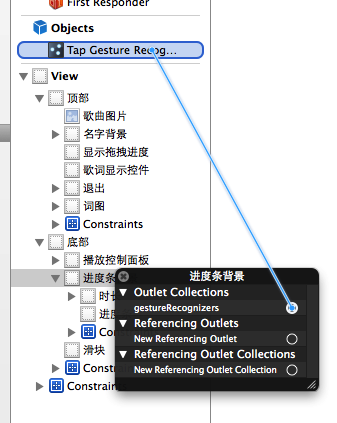
往掌握器拖線:
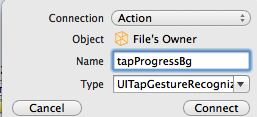
觸及的代碼:
/**
*點擊了進度條
*/
- (IBAction)tapProgressBg:(UITapGestureRecognizer *)sender {
//獲得以後單擊的點
CGPoint point=[sender locationInView:sender.view];
//切換歌曲確當前播放時光
self.player.currentTime=(point.x/sender.view.width)*self.player.duration;
//更新播放進度
[self updateCurrentTime];
}
(2)拖拽進度條
先添加拖拽手勢辨認器

往掌握器拖線
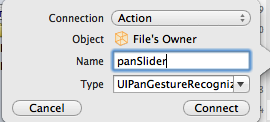
觸及的代碼:
/**
*拖動滑塊
*/
- (IBAction)panSlider:(UIPanGestureRecognizer *)sender {
//1.取得移動的間隔
CGPoint t=[sender translationInView:sender.view];
//把移動清零
[sender setTranslation:CGPointZero inView:sender.view];
//2.掌握滑塊和進度條的frame
self.slider.x+=t.x;
//設置進度條的寬度
self.progressView.width=self.slider.center.x;
//3.設置時光值
CGFloat sliderMaxX=self.view.width-self.slider.width;
double progress=self.slider.x/sliderMaxX;
//以後的時光值=音樂的時長*以後的進度值
NSTimeInterval time=self.player.duration*progress;
[self .slider setTitle:[self strWithTime:time] forState:UIControlStateNormal];
//4.假如開端拖動,那末就停滯准時器
if (sender.state==UIGestureRecognizerStateBegan) {
//停滯准時器
[self removeCurrentTime];
}else if(sender.state==UIGestureRecognizerStateEnded)
{
//設置播放器播放的時光
self.player.currentTime=time;
//開啟准時器
[self addCurrentTimeTimer];
}
}
【iOS開辟中音頻對象類的封裝和音樂播放器的細節掌握】的相關資料介紹到這裡,希望對您有所幫助! 提示:不會對讀者因本文所帶來的任何損失負責。如果您支持就請把本站添加至收藏夾哦!
- iOS xxx.pch
- iOS開發從入門到精通-- 滾動視圖UIScrollView高級,協議。
- iOS 漢字轉拼音
- ios提交市場報錯誤ERROR ITMS-9000: "this bundle is invalid. armv7s are required to include armv7 architectur
- iOS UIWebView 加載https站點出現NSURLConnection/CFURLConnection HTTP load failed (kCFStreamErrorDomainSSL,
- iOS動畫詳解
- IOS學習筆記38——NSJSONSerialization使用
- IOS開發判斷在字符串中是否包含相應的字符
- 詳解iOS App中圖片的線段塗鴉功效的添加辦法
- iOS學習筆記—— MapKit

